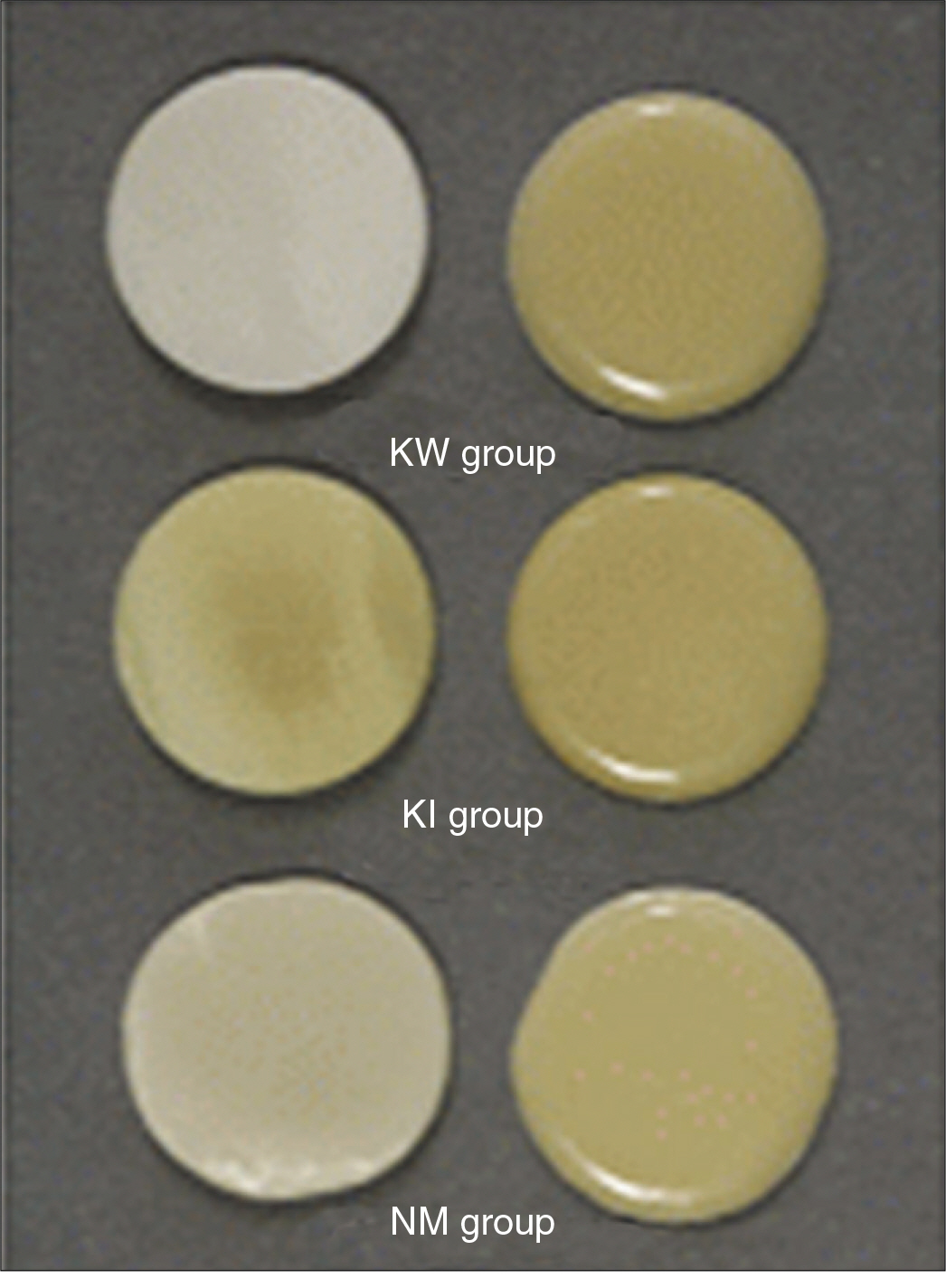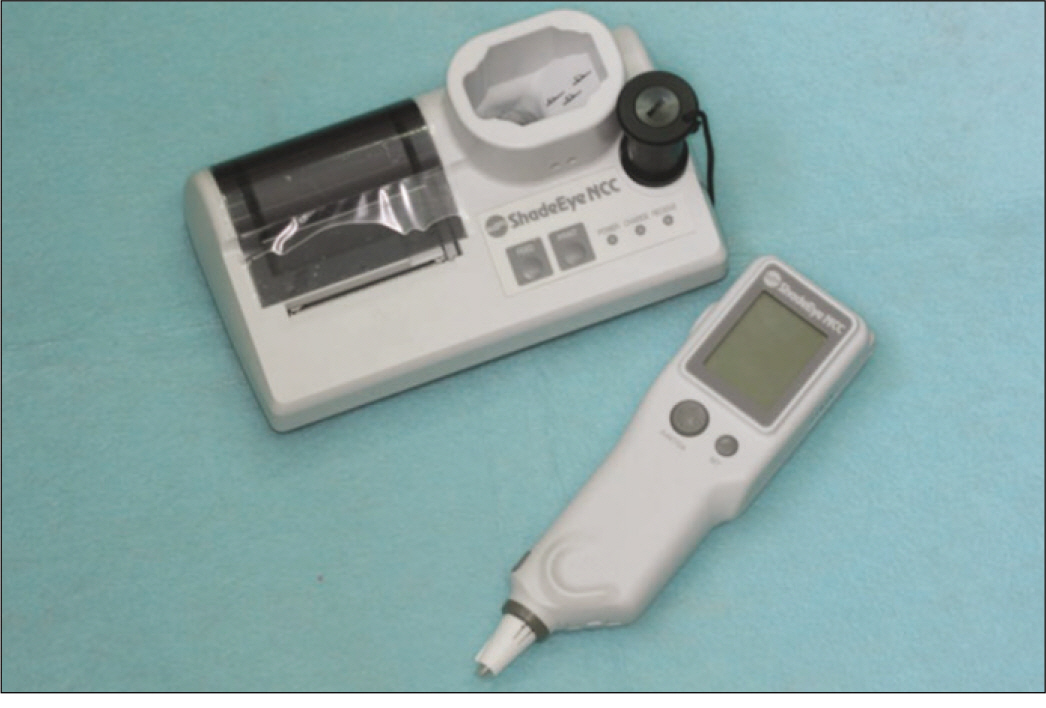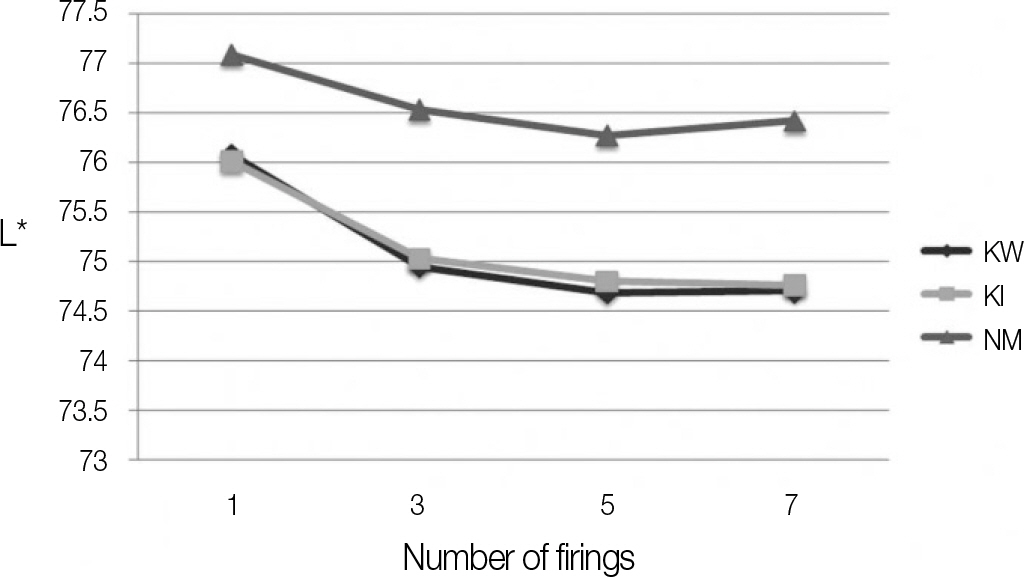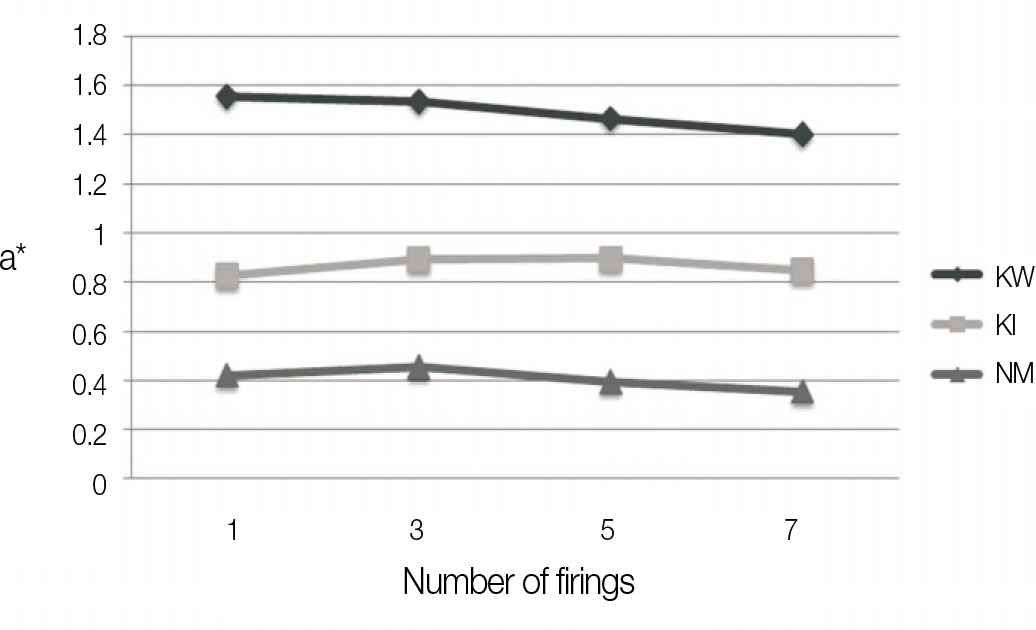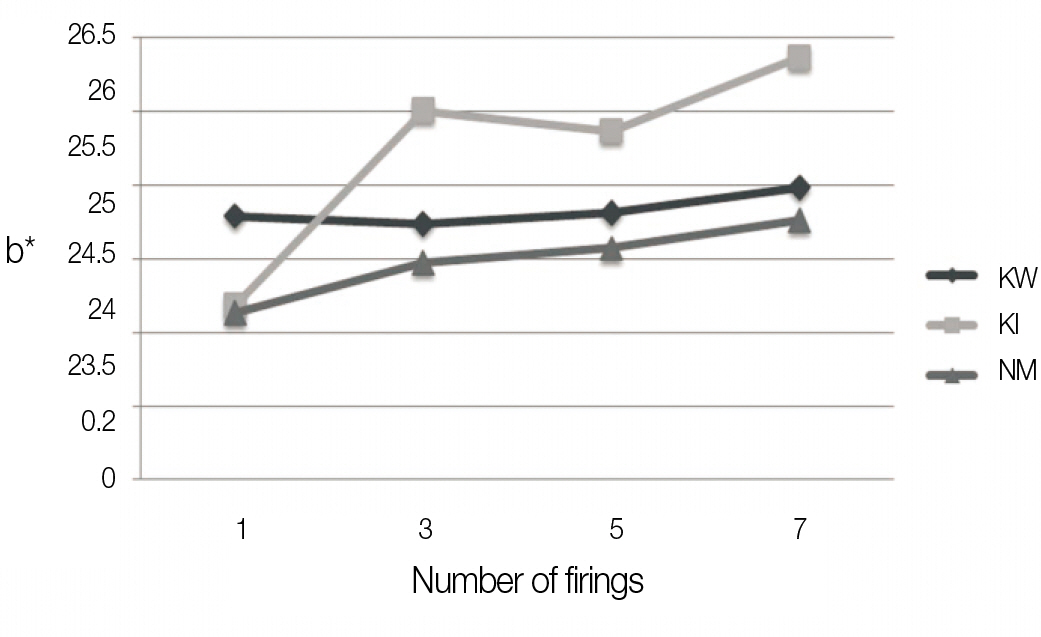J Korean Acad Prosthodont.
2011 Jan;49(1):73-79. 10.4047/jkap.2011.49.1.73.
The effect of repeated firings on the color of zirconia-based all-ceramic system
- Affiliations
-
- 1Department of Prosthodontics, School of Dentistry, Pusan National University, Yangsan, Korea. jeonyc@paran.com
- KMID: 2000286
- DOI: http://doi.org/10.4047/jkap.2011.49.1.73
Abstract
- PURPOSE
The aim of this study was to evaluate the effect of repeated firings on the color of zirconia restoration with different shading method.
MATERIALS AND METHODS
Three different types of zirconia frameworks (adding metallic pigments to the initial zirconia powder before sintering (Group NM), dipping the milled frameworks in dissolved coloring agents (Group KI), or application of liner material to the sintered white frameworks (Group KW) were used to support A3 shade dentin porcelain. Repeated firings (3, 5, or 7) were performed, color differences among ceramic specimens were measured using a colorimeter. Repeated measurements analysis of variance (ANOVA) was used to analyze the data for significant difference. The Tukey Honestly Significant Different (HSD) test was used to perform multiple comparisons (alpha = .05).
RESULTS
1. L*a*b* values of the ceramic systems were affected by the number of firings (1, 3, 5 or 7 firings) (P < .001) and shading methods (P < .001). 2. As the number of firings increased, the L* (for all groups) and a* value (for KW and NM groups) decreased and the b* value(for all groups) increased. 3. The mean color differences caused by repeated firings were perceptible (DeltaE > 1) for group KW and KI fired after 3 times, except for group NM fired after 7 times. 4. In order of decreasing DeltaE value fired after 7 times, the values were group KI(DeltaE = 2.26) > group KW (DeltaE = 1.47) > group NM (DeltaE = 1.08) (P < .001).
CONCLUSION
Repeated firings influenced the color of the zirconium-oxide all-ceramic specimens with different shading methods.
Keyword
MeSH Terms
Figure
Reference
-
1.Daniel C., Drummond J., Giordano RA. Improving Flexural Strength of Dental Restorative Ceramics Using Laser Interference Direct Structuring. J Am Ceram Soc. 2008. 91:3455–7.
Article2.Rosenblum MA., Schulman A. A review of all-ceramic restorations. J Am Dent Assoc. 1997. 128:297–307.
Article3.Guazzato M., Albakry M., Ringer SP., Swain MV. Strength, fracture toughness and microstructure of a selection of all-ceramic materials. Part II. Zirconia-based dental ceramics. Dent Mater. 2004. 20:449–56.
Article4.Guazzato M., Albakry M., Swain MV., Ironside J. Mechanical properties of In-Ceram Alumina and In-Ceram Zirconia. Int J Prosthodont. 2002. 15:339–46.5.Jeong HC. Fracture strength of zirconia monolithic crowns. J Korean Acad Prosthodont. 2006. 44:157–64.6.Aboushelib MN., Kleverlaan CJ., Feilzer AJ. Effect of zirconia type on its bond strength with different veneer ceramics. J Prosthodont. 2008. 17:401–8.
Article7.Shah K., Holloway JA., Denry IL. Effect of coloring with various metal oxides on the microstructure, color, and flexural strength of 3Y-TZP. J Biomed Mater Res B Appl Biomater. 2008. 87:329–37.
Article8.Yilmaz B., Ozçelik TB., Wee AG. Effect of repeated firings on the color of opaque porcelain applied on different dental alloys. J Prosthet Dent. 2009. 101:395–404.
Article9.Ozturk O., Uludag B., Usumez A., Sahin V., Celik G. The effect of ceramic thickness and number of firings on the color of two all-ceramic systems. J Prosthet Dent. 2008. 100:99–106.
Article10.Celik G., Uludag B., Usumez A., Sahin V., Ozturk O., Goktug G. The effect of repeated firings on the color of an all-ceramic system with two different veneering porcelain shades. J Prosthet Dent. 2008. 99:203–8.
Article11.Devigus A., Lombardi G. Shading Vita YZ substructures: influence on value and chroma, part I. Int J Comput Dent. 2004. 7:293–301.12.Heffernan MJ., Aquilino SA., Diaz-Arnold AM., Haselton DR., Stanford CM., Vargas MA. Relative translucency of six all-ceramic systems. Part I: core materials. J Prosthet Dent. 2002. 88:4–9.
Article13.Antonson SA., Anusavice KJ. Contrast ratio of veneering and core ceramics as a function of thickness. Int J Prosthodont. 2001. 14:316–20.14.Lee YK., Cha HS., Ahn JS. Layered color of all-ceramic core and veneer ceramics. J Prosthet Dent. 2007. 97:279–86.
Article15.O'Brien WJ., Kay KS., Boenke KM., Groh CL. Sources of color variation on firing porcelain. Dent Mater. 1991. 7:170–3.16.Uludag B., Usumez A., Sahin V., Eser K., Ercoban E. The effect of ceramic thickness and number of firings on the color of ceramic systems: an in vitro study. J Prosthet Dent. 2007. 97:25–31.
Article17.Crispin BJ., Hewlett E., Seghi R. Relative color stability of ceramic stains subjected to glazing temperatures. J Prosthet Dent. 1991. 66:20–3.
Article18.Lund PS., Piotrowski TJ. Color changes of porcelain surface colorants resulting from firing. Int J Prosthodont. 1992. 5:22–7.19.O' Brien WJ., Groh CL., Boenke KM. A new, small-color-difference equation for dental shades. J Dent Res. 1990. 69:1762–4.20.American Dental Association Council on Scientific Affairs. Dental shade guides-acceptance program guidelines. Chicago: American Dental Association;2001. p. 4.21.Johnston WM., Kao EC. Assessment of appearance match by visual observation and clinical colorimetry. J Dent Res. 1989. 68:819–22.
Article
- Full Text Links
- Actions
-
Cited
- CITED
-
- Close
- Share
- Similar articles
-
- The effect of repeated firings on the color change and surface roughness of dental ceramics
- The effect of ceramic thickness and number of firings on the color of a zirconium oxide based all ceramic system fabricated using CAD/CAM technology
- The effect of repeated firings on the color change of dental ceramics using different glazing methods
- Effect of the shades of background substructures on the overall color of zirconia-based all-ceramic crowns
- Comparison of the translucency of shaded zirconia all-ceramic systems

